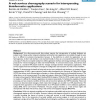1414 search results - page 269 / 283 » Randomness and Universal Machines |
TRS
2008
13 years 9 months ago
2008
A popular view is that the brain works in a similar way to a digital computer or a Universal Turing Machine by processing symbols. Psychophysical experiments and our amazing capabi...
APAL
2002
13 years 9 months ago
2002
The paper introduces a semantics for the language of classical first order logic supplemented with the additional operators and . This semantics understands formulas as tasks. An ...
BMCBI
2004
13 years 9 months ago
2004
Background: Very often genome-wide data analysis requires the interoperation of multiple databases and analytic tools. A large number of genome databases and bioinformatics applic...
AI
2000
Springer
13 years 9 months ago
2000
Springer
The World Wide Web is a vast source of information accessible to computers, but understandable only to humans. The goal of the research described here is to automatically create a...
COMPUTER
2002
13 years 9 months ago
2002
tail defines the level of abstraction used to implement the model's components. A highly detailed model will faithfully simulate all aspects of machine operation, whether or n...

